If you are as frugal as we are, then you probably get a thrill from finding a deal. But did you know that you could turn the thrill of the hunt into a profitable retail arbitrage business?
Sometimes you’ll see a great bargain but have no use for the item. Ugh! That’s frustrating.
But there are some people who have turned their treasure hunting into a full-time income. They have honed their shopping and selling skills by buying low and selling high.
We’ll share four of their stories later in this article (and how much they earn each year).
In this article we’ll walk you through:
- What Retail Arbitrage is
- Some of the tools that make it easier to succeed
- Meeting four super successful Retail Arbitrageurs
TABLE OF CONTENTS
- 1 What is Retail Arbitrage?
- 2 Is Arbitrage Legal?
- 3 Can You Really Make Money with Retail Arbitrage?
- 4 Get Started with Retail Arbitrage on eBay, Etsy & Amazon
- 5 How to Find Good Deals that Will Resell Easily
- 6 Where to Find Items to Sell
- 7 Meet 4 Successful Retail Arbitrage Sellers
- 8 Rob & Melissa Stephenson: Flea Market Flippers – $84K in Earnings
- 9 Jessica & Cliff Larrew: The Selling Family – $60k – $100k in Earnings
- 10 Scott & Joany Zilke: The Bearded Picker – $70k in Earnings
- 11 Tyler Philbrook: I am the Future Me – $15k in Earnings
- 12 Advice for Getting Started
What is Retail Arbitrage?
Retail arbitrage is the simple concept of buying low and selling high. Find a deal and turn around and re-sell it.
First, you look for a great deal on an item (well below retail price). Once you purchase the item, the next step is to sell it at its regular price. The difference between your buy price and your selling price is what you get to keep … profit. We like profit!!!
For example, let’s say you found a cookie sheet that was originally priced at $30 but you found it on sale for $10. Once you purchase the item, then you would sell it for $30. That would leave $20 of profit for you to use on your next deal.
That’s retail arbitrage … It really is that simple!
Is Arbitrage Legal?
Your next question is probably, “is retail arbitrage even legal?”
According to Investopedia Arbitrage is:
“The exploiting of price discrepancies within different markets of similar or identical assets in order to generate low-risk to no-risk profits, after accounting for transaction and information costs. Arbitrage trading is not only legal in the United States, but should be encouraged, as it contributes to market efficiency.”
As you can see if investment arbitrage is legal, so is retail arbitrage. We would never recommend an illegal way to make money. Life is too short for that!
It may honestly feel too good to be true but if you are a great bargain hunter then you will likely be able to make profitable income with this practice.
Can You Really Make Money with Retail Arbitrage?
You can absolutely make money through buying and selling items. If you follow the tips in this article and learn to use some of the tools, you’ll be more likely to make a profit. However, you need to make sure to account for other costs that could cut into your profit.
Two important things to consider before you decide on a purchase:
- Account any selling fees required for resale platforms like Amazon or eBay
- Calculate Shipping costs.
You may be wondering who on earth would pay full price for something when there is a bargain to be found?
- Luckily for us, not everyone is so bargain-savvy. Even if someone is capable of finding a great deal, they may not have the time it would take to go to the store and find it. It is infinitely easier to hop on the internet and buy whatever you need from the comfort of your home. The desire for convenience and impulse buying could mean big profits for you.
- Restrictions due to regional availability may force someone to purchase a product at a higher price online because it simply is not available near them.
For example, certain types of ethnic foods may only be available outside of your town.
Beef Crackers from New Guinea – Steve & Annette from MoneySmartFamily.com have a son-in-law who grew up there. He loves Morobeen Beef Crackers. They’re hard to find in the U.S.
Laddu from India – we have some Indian friends who are living in the U.S. They would pay dearly for a great taste of home. (laddu is a round cookie made from chickpea flour and ghee)
Cuban Cookies – Sarah Sharkey (writer of this article) has a passion for these, but they are hard to find in her hometown of Gainesville, Florida.
Many people are stuck in similar situations and are willing to pay a premium for a favorite food from their past.
Get Started with Retail Arbitrage on eBay, Etsy & Amazon
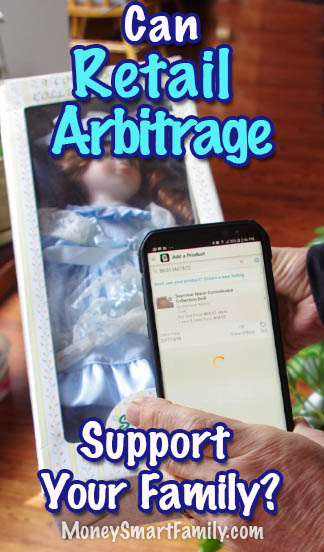
In order to successfully create a stream of income from retail arbitrage, you will need to find a way to sell your products.
As you choose your method, remember that there isn’t just one way to do this. Choose the platform or methods that are most comfortable for you.
You may find that having multiple platforms to work in is most effective for you or you may choose to focus your efforts on a single resale pathway.
Here are four of the most popular resale pathways for retail arbitrage:
1. Sell Locally for Cash
Online Listing Services
One way to keep things simple is to just resell items in your local area. The benefit of this method is that you can avoid any selling fees. You could sell items to an individual via Craigslist, OfferUp, Facebook Marketplace or Facebook Swip Swap groups.
Fees: Usually none
Consignment Stores
Or you could sell through a local consignment store and received either cash or store credit. While this method will most likely earn you the least amount of money, you won’t have to deal with responding to inquiries, setting meetups or haggling with buyers.
Fees: these vary store by store. Expect to pay somewhere between 30 to 60 percent.
2. Sell on eBay
Posting your items for sale on eBay will give you access to thousands of potential buyers. Although you may have to pay a listing fee, the access to a huge marketplace of customers may be well worth the effort. As a seller on eBay, you will be responsible for your own shipping directly to the customer.
Fees: Usually Ebay lets you list 50 items for free each month. They do charge a final value fee of 10% (on the item price and shipping charged). Fees vary depending on the type of item you are selling.
Read the eBay Guide to Selling on their platform.
3. Sell on Etsy
If you have a knack for repurposing items, then you could easily get started with retail arbitrage on Etsy. Although you will need to add the step of sprucing up your finds, it could be a lucrative way to put your creative skills to the test.
One successful retail arbitrage seller uses her creative skills to repurpose thrift store dolls into haunted dolls. She finds dolls at thrift stores for between $1 and $3 each then sells them on Etsy for between $20 and $30. Although Etsy sellers have to pay certain fees and shipping, this is an example of a great profit margin through retail arbitrage.
Read the Etsy Sales Rules about what you can and cannot sell on the site. Given the restrictions, this may not be a great fit for everyone. Specifically, they are looking for handmade or vintage items. You will need to add your own creative touch or ensure that the items are truly vintage or antiques.
Fees: Etsy charges a listing fee of $.20 per item. A transaction fee of 5 percent when an item sells. They also charge an additional 5 percent of what you charge for shipping and handling.
4. Sell on Amazon
There are two ways you can sell items through Amazon.
- List and Self Fulfill: You can list your items and fulfill them yourself. Amazon charges a fee when the item sells, but you have the ability to reach a huge audience.
- List and allow Amazon to Fulfill: Amazon FBA is a popular way for sellers to create a profitable retail arbitrage income stream. FBA stands for “Fulfilled by Amazon.”
The Advantages of Amazon FBA
If you are a seller through the platform, you are allowed to ship multiple items to the Amazon warehouse for a greatly reduced shipping rate. When an item sells, Amazon ships your item at no charge to the customer (Amazon Prime members).
Amazon will also promote your items more through Google ads and internal promotions to increase sales.
One FBA seller said that he sold 4 times as many items when he did FBA versus self-fulfillment.
Through Amazon, you also gain access to thousands of eager consumers. Many of the buyers on Amazon are regular purchasers who are looking to fill their next order.
As an FBA seller, your items will be categorized as Prime options, which will allow a customer to order the item with free 2-day shipping.
These features allow you the potential to create an income stream with less hands-on involvement than other methods.
Fees: Of course, there is a trade-off. The fees charged by Amazon are relatively high between 15 and 30 percent.
You will need to decide whether or not the fees are worth the perks in your particular situation. If you are interested in learning more about selling on Amazon read the Amazon Quick Start guide.
You can see the Amazon Fee Structure here.
You can see the Amazon FBA Fee Structure here.
How to Find Good Deals that Will Resell Easily
You may be a pro a finding the perfect deal for yourself but that doesn’t necessarily translate into deals that will sell. When you are in the store, you don’t want to just guess whether or not an item will sell for a profit online.
For example, my favorite leather bomber jacket that I scored for $5 is not a great candidate for retail arbitrage even though it was an outstanding deal.
Expecting everything you post to sell for the expected profit is just not realistic.
If you choose to just guess whether or not a deal will make money, then you will likely start to lose money on deals.
You need to make a rational decision based on dollar amounts for each purchase. Luckily, there are several apps that make this process easy.
Many Amazon FBA resellers say that they only will buy items to sell on Amazon if the sales rank is 50,000 or higher. They only want to warehouse things for a short time, so they’re looking to buy best selling products.
Amazon
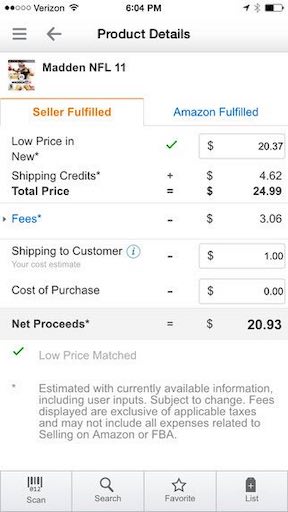
If you are working with Amazon, then you should use the free seller app (links below) that will allow you to scan the barcode and uncover large amounts of data on each product.
The Amazon app will show you the lowest price the item is being sold for, the fees that FBA will charge, and finally the expected profits.
Also, it will allow you to check the rank of the item. If the item has a high Amazon Best Seller Ranking, then you will be more likely to sell it easily.
One profitable Amazon FBA seller said that they only buy and sell items that rank 50,000 or above on Amazon’s best selling list. They learned that anything lower just sat in their garage for a long time before selling.
Get the Amazon Seller app here:
Bookscouter
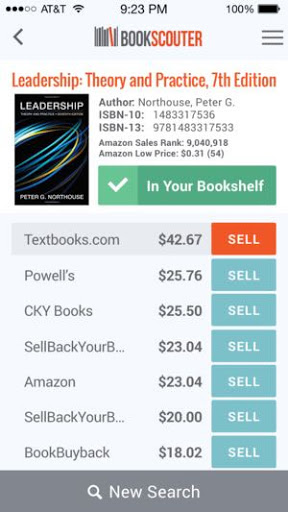
If you choose to focus on books, then consider the Bookscouter app (link below) to save you time and make you money.
Just scan the barcode and find the current value of that book on several different selling platforms. With this information, you will be able to make a better decision about which books to purchase and which to pass on.
You can use this app when evaluating books at garage sales, thrift stores and in your home.
Get the Bookscouter app here:
Related Article: Roadmap to Savings for Garage Sale Treasures
Profit Bandit

Profit Bandit is a popular paid app that allows you to scan an item and gain access to resale information. It offers a broader perspective than the Amazon seller app but the price may be unnecessary for beginners.
Profit Bandit is advertised as the #1 Amazon Scouting App. FitForBusiness.com rated this app as a good choice for Small & Growing Amazon Resellers.
Profit Bandit costs $9.99 per month.
Get the Profit Bandit app:
Where to Find Items to Sell
Finding items to sell can be a fun challenge. If you are considering starting this as a side hustle, then start with a store you normally frequent for deals. The most important thing to remember is to buy low and sell high, think of stores in your area that offer great prices on quality things.
Here are some places to get started:
- Garage sales. You never know what you are going to find but that is part of the fun. Plus you are typically able to negotiate on the price to get an even better deal.
- Thrift stores. Make sure to take advantage of the discount days. Many thrift stores have rotating sales that can help to increase your profit margin dramatically.
One Phoenix man visits 10 to 20 Goodwill stores on half–price Saturdays every other week and buys all of the hockey and ice skating equipment he can find. Then he takes it to a few consignment stores in Phoenix and Northern Arizona to earn approximately $3,000 a month.
- Bookstores and library sales. Check out used bookstores and Friends of the Library sales to find deals on great retail arbitrage items.
- Grocery stores. Finding non-perishables on sale or closeout can turn into a reasonable profit.
- Store closing sales. Just because a store is closing does not mean that the items are all junk. Stores close for a variety of reasons. You can pick up some super discounted bargains and turn them into profit
- Drug stores like CVS, Walgreens, and Rite Aid. Smaller drug stores are less intimidating for beginners to get started. You can easily find profitable deals in their clearance section.
One of the retail arbitrage experts (Tyler Philbrook) we interviewed got his start buying discounted at Walgreens and resold them for a profit. - Target. The inner edge of the aisles is filled with clearance deals that could turn a profit.
- Walmart. The low prices leave room for opportunity.
- Flea markets. The deals found here are always a surprise. Keep reading to learn about a family that started their arbitrage business shopping at Flea Markets.
- Dollar stores. Finding a deal here is usually easy but make sure that the profit margin is worth the effort.
Related Article: Best Online Dollar Stores
- Toy stores. Children’s toys are continually put on clearance to make room for the next great toy. If you can find a great clearance deal then it will be easy to resell the item for a profit.
- Discount stores. There are several discount stores that offer great deals for sellers, check out Tuesday Morning, TJ Maxx, Ross, and Marshalls for your next find.
- Department store clearance racks. Dillards, Macy’s, and similar department stores have great deals available in their clearance section. Specifically, make sure to check out their designer purse sections. Sometimes you can find a designer purse for up to 75% off, which can turn into a large profit margin.
Maximize your profits by combining clearance items with coupons to get the best deal possible.
Related Article: Couponing for Beginners
Meet 4 Successful Retail Arbitrage Sellers
In order to understand what retail arbitrage is really all about, we decided to interview three successful sellers. Although each has different experiences they all offer an interesting perspective on this making money game with retail arbitrage.
Remember, these success stories did not happen overnight. It took time, determination, and perseverance from each of these sellers to create a worthwhile income.
Do not be discouraged if it takes time to reach your goals.
The following interviews are with successful retail arbitrage buyers and sellers. All of them have made this their primary income source.
They are organized by approximate annual earnings starting with the highest first.
- Rob & Melissa Stephenson – The Flea Market Flippers – 2 different Flipper U Courses
- Cliff & Jessica Larrew – The Selling Family – 2 FBA Courses (free email course also)
- Scott & Joany Zilke – The Bearded Picker – YouTube Channel and Patreon Channel
- Tyler Philbrook – I am the Future Me
Rob & Melissa Stephenson: Flea Market Flippers – $84K in Earnings
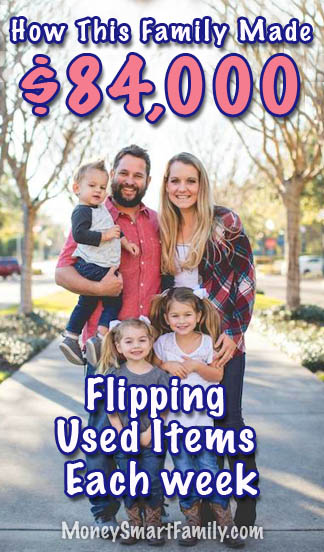
How to run a profitable arbitrage business from your home. An interview with Rob & Melissa Stephenson and known as the Flea Market Flippers.
Rob has used retail arbitrage to successfully quit his job and work from home. Together with his wife Melissa, they have been able to support their family with their flipped items. They teach others how to be successful flippers through Flipper University.
In order to get a better understanding of how they earn a living and how well retail arbitrage works for their family, we asked them six questions about their business. Our hope is that their answers will give you a clearer path to building a profitable side-hustle or full-time business.
How did you get started in Flea Market Arbitrage?
I actually started flipping items to make money when I was 16 years old. I saw my mom do it some with baby clothes. She would buy them at yard sales and then sell them in the classified section of the newspaper. (Does anyone remember those?)
The first items I sold were NordicTrack Ski machines. You could pick them up dirt-cheap here in Florida. People would move here from up North and then realize they could walk outside most of the year. Then they would get rid of them at a yard sale. I bought them and resold them on eBay to people up North who wanted one.
Once you got started how long did it become profitable?
It didn’t take long to build a profit. I never invested much in the items I would buy. This has been a side-hustle for me for the past 22 years. Only recently (about 3 years ago), did we go full-time.
When did you reach $1,000 in profits?
I earned my first $1000 in profit when I was 16 years old! I would buy those unwanted NordicTrack machines for $20 to $30. I’d clean them up and then resell them for $200 to $900 depending on the model. It was an easy way to make money.
Are your earnings consistent each month?
There are ups and downs, but it’s more because of me, not the market. I am not always consistent in listing items and my sales sometimes reflect that.
We do have some months that are really big (like $11,000 – $17,000 in sales), and some that are lower (Like $3,000- $5,000). So we do have to plan for that.
Is this your full-time income or a supplemental income?
It’s our full-time income now. We went from part-time to full time in April of 2016.
Melissa had planned to stop her personal training job in 2016 when our son was born.
Life was already crazy in our house with a one-year-old and a three-year-old. We knew that a newborn would put us over the top.
A month before our son was born I was informed at my job that our health insurance would not be renewed the following month (April 2016). Our son was due on April 1st. Melissa and I were praying he would be born by the end of March! Fortunately, he WAS born on March 23rd.
Having health insurance was the main reason I was still at that job. So when it was canceled we made the decision to take our flipping gig full-time.
What better time to do it than when you have a new infant and two little ones at home!
How much do you earn each year?
To be honest, our flipping income was more of a hobby for years and we didn’t keep awesome records. It was our “fun money” or “extra” when we needed it.
For example, our friends planned a whole trip around Ireland and three weeks before they were set to go they told us we needed to come with them. So I went and figured out what I could flip to make the money to take the trip. We sold some things and ended up having an amazing trip with them!
Another example – I was looking at cruises online one night (this was before we had kiddos), and found a 2-week TransAtlantic cruise for an amazing price! But it was leaving the following month. Melissa told me that if I could make the money from flipping we could go if she could take off work.
Well I made the money and she was able to take off and we enjoyed an amazing 14-day cruise from Florida to France, Spain, and Italy! It’s still one of our favorite trips to this day!
The past three years we have really treated flipping as a business and because of that, we have been able to grow it.
On our blog, we share income reports because we personally have found them to be motivating for us. We recently started blogging because we always found it so inspiring to read what others were doing. Our hope is that we inspire others to make income through flea market/garage sale arbitrage, so we regularly share our monthly income or yearly income on the blog.
In May of 2016, we started to work the business full-time. That year we made $133,000. We share our monthly income reports on our FleaMarketFlipper blog.
In 2017 we made $95,000 from flipping items while simultaneously growing our blog and helping others get into flipping.
Our 2018 FleamarketFlipper income report shows earnings of $84,985. But we only worked about 14 to 20 hours each week to reach that amount of income.
We do flip full-time, but we don’t work full-time hours. We definitely value family time and spend a good amount of time with our kids.
Multiple Streams of Income
But we also have the second part of our business and that is teaching others what we do and helping them get started! We spend way more time each week filming videos, writing articles, and answering questions for our members than we do actually flipping right now. So we were happy with the $85K with the time we earned doing flea market arbitrage.
What is your number one tip for anyone considering retail arbitrage?
Retail arbitrage isn’t exactly what we do. That is more what Amazon sellers do. We have actually never sold on Amazon and really don’t have a desire to do so.
That seems more like a real business and numbers to us. My favorite part of this business is the hunt for treasure. I love the rush of a good deal.
Retail arbitrage is when resellers buy from a retail store at a low price (usually clearance or sale) and then sell the item on another platform like Amazon.
We deal with mostly used items that are bought from flea markets, thrift stores, and local online apps. We don’t typically source at a retail store.
But my number one tip for anyone considering flipping items for a profit or selling on eBay is:
“Start small and grow it quickly.”
There is no need to start buying huge inventories right off the bat. You can start small with $20 or less and grow it from there. We find items for free to $20 regularly. Flipping those items, we can easily make a couple of hundred dollars on them.
Another HUGE tip I would give is to BE CONSISTENT!
- Consistently look for items.
- Consistently list items
- Then you will consistently sell items and make money!
And that doesn’t mean someone has to spend hours and hours each week on flipping. You would be surprised what just a few hours a week consistently could do for your flipping business as a side hustle.
FleaMarketFlippers Learning Opportunities:
FREE Webinar to Learn Their Flipping Methods
Join Rob & Melissa for a Free Webinar. This webinar is pre-recorded, so you can access it right now!
Besides lots of actionable information, you’ll also receive a free e-book, “The Beginners Guide to Selling on Ebay.” And they’ll also give you a $100 discount on their FleaMarket Flipper University course.
Rob & Melissa have a course that teaches you their strategies.
There are 2 options:
- Pro-Flipper Package $497
Earning Potential: $500-$3,000 per month - Pro-Flipper PLUS Package $597
Earning Potential: $3,000- $7,000+ per month
Get the details on both Flipper University options here.
Video of Rob & Melissa
Watch this video where Rob & Melissa explain how they earned more than $17,000 in one month of flipping:
Jessica & Cliff Larrew: The Selling Family – $60k – $100k in Earnings
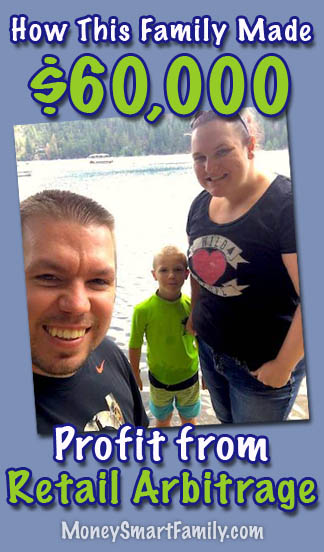
Jessica Larrew from the Selling Family has been incredibly successful with retail arbitrage through Amazon FBA. Some years they have sold as much as $300,000 in merchandise and earned a profit of $100,000.
Jessica teaches others how to grow their own Amazon FBA business through her Amazon Boot Camp course. In the course Jessica shares tips on how to get started and grow your business quickly. If you are interested in learning more about retail arbitrage and the details of an Amazon FBA business, then you should definitely consider taking this course.
Learn how they got their start selling on Amazon and what works best for their family.
How did you get started?
Long before I imagined I’d be a six-figure reseller, I was selling items on eBay for fun while working a full-time job. I’ve always had an eye for spotting good deals and I definitely enjoy the thrill of the hunt! So it was great to have a hobby that actually made some extra money.
When I got laid off from my job in 2008 (tell me if you’ve heard that one before!), I had to get serious about my “hobby”.
I took the money from my last paycheck and instead of buying new suits for job interviews, I decided to go all-in on eBay selling. I needed the absolute biggest return on investment that I could get, so I bought all of my inventory at yard sales and thrift stores.
Once you got started how long did it become profitable?
I was profitable almost immediately, largely because I focused on buying items for a really low price that I could sell for big margins. If my inventory costs had been higher, that would have really eaten into my profit at the time.
My problem wasn’t that I couldn’t find enough profitable items, it was that I was running out of hours in the day.
With eBay, I had to:
- Shop for inventory
- Create my own listing
- Pack up the item and ship it to the customer when it sold.
- I also had to deal with stuff like customer complaints and returns.
So I was profitable, but not in a way that would have really allowed me to grow the business quickly.
When did you reach $1,000 in profits?
I have to be honest, in the beginning, I wasn’t really tracking my profits. What would happen would be I’d make some money and then if we needed it to pay bills (which we did at the time), I would just put that money right towards the rent.
But I can tell you when our profits started to become steady and that’s when I switched from eBay to using Amazon FBA.
This was back in the summer of 2010 when Amazon FBA was relatively new. I actually heard eBay sellers talking about it and it sounded great.
If you’re not familiar with Fulfillment by Amazon (Amazon FBA) read our Beginners Guide, it’s Amazon’s special fulfillment program that makes selling easier for third-party sellers.
Basically, I send all my inventory to Amazon at once (at a discounted rate), and then they handle stuff like storing the items in their warehouses, shipping the items to customers (with free 2-day shipping no less), and dealing with customer service.
It was this move to FBA that allowed me to grow my business and start seeing consistent profits. Even though I was only working on Amazon in a part-time capacity, I was able to replace my old income plus my husband’s management income in just a couple of years.
Are your earnings consistent each month?
My earnings are consistent if I’m consistent. What I mean is that I have to keep sending in inventory to the Amazon warehouses to make a profit.
If I want to profit $5,000 in a certain month, then I know I need to send in about $5,000 of inventory (that’s at my cost) to Amazon. Because I have high ROI standards, I like to send in inventory that will let me double my money. So every dollar I spend should bring me back an additional dollar in profits.
Because I buy my inventory with the Retail Arbitrage method, that means I need to spend $5,000 per month at stores like Target, Big Lots, or Walgreens. If I can leave one store with a big haul of say $1,000, then that lightens my shopping load for the rest of the month.
The only time Amazon income really varies for me is during the holiday season of November – December. And during this short time period, sales are WAY up. In fact, I have made as much as half of my yearly Amazon earnings in just the last couple of months of the year before. It’s great because we can use our December profits to invest more in the business at the start of the year.
Is this your full-time income or a supplemental income?
Amazon is not currently my full-time income, but that’s because we now also have our blog and courses to work on.
We never actually worked on Amazon FBA for full-time hours, but it was our sole, full-time income for several years. When I helped my husband Cliff retire from his 9-to-5 job in 2011, we made Amazon FBA our sole income. In the first year of us both working on it together, we had $300,000 in sales. That left us a profit of $100,000.
Before that, I was just working on Amazon FBA when Cliff was home from work and able to watch our son. So even just working on Amazon for a few hours each week, I got to a place where I was comfortable with having Cliff and I both take the business full time.
How much do you earn in total each year?
When we worked on Amazon together full-time, we typically did about $300,000 in sales per year.
Now that we have other businesses, that number is much lower. These days, we work on Amazon FBA for about 5 hours each week and we see monthly sales of about $5,000.
What is your number one tip for anyone considering retail arbitrage?
Never give up!
The mistake I see again and again is that new sellers give up too quickly. Typically when they’re just on the verge of being successful.
Doing Retail Arbitrage, where you’re spending hours in stores searching for profitable inventory, can be pretty exhausting when you’re just getting started. But once you get the hang of it, you’ll start spotting good deals quickly.
Retail Arbitrage and Amazon FBA are not get-rich-quick schemes. So don’t expect to be profitable by the end of your first week! And don’t give up before you really give it a chance.
If you have a little patience and treat Amazon like a real business, you’ll see your efforts rewarded. I think that taking a training course (see resources after this interview) can really help you make a profit faster and reduce the number of mistakes you make along the way.
Remember, you can always just test the waters with Retail Arbitrage. Hit a few of your favorite stores and start looking for deals. There’s no need for a huge investment of time or money right off the bat. It’s always important to build a business that works for you.
The Selling Family Learning Opportunities:
Free Email Course: Jessica has a free 7 Day Email Course: Everything You Need to Know to Get Started Selling on Amazon. This is the best place to start if you want to dip your toes in the FBA waters.
How to Get Started Blog: How To Sell on Amazon FBA: This is Jessica’s guide that explains how and why the Amazon FBA business model works.
Amazon Boot Camp Course: This Video eCourse Boot Camp does cost money, but people who have taken the course say it pays for itself. One guy made his money back in just 2 weeks. The cost for the course between $197 and $347 depending on which options you select.
Read the Amazon Boot Camp Info page – it’s full of details and testimonials about the course.
Video of Cliff Explaining FBA
Watch this video as Cliff explains how they made more than $3000 by sourcing and buying one product.
Scott & Joany Zilke: The Bearded Picker – $70k in Earnings

Scott is a bonafide bargain hunter; it’s in his blood. His mother and grandmother were avid garage sale shoppers. So it’s natural that he picked up the bug from them.
Related Article: Roadmap to Savings for Garage Sale Treasures
He got a nose for deals and the drive to hunt them down. On his extensive YouTube Channel, he describes himself as … A “Wandering picker who trades his finds on Amazon FBA and eBay.”ƒ
If you watch any of his videos you’ll be entertained and amazed by his ability to find deals that he turns into cash. He also has several videos where he teaches the ins and outs of Fulfillment by Amazon (FBA). Scott also does some YouTube Live videos where he talks with other FBA pros sharing tips and tricks to be successful.
He’s usually on the road every other week. His wife goes on every other trip. He said there seems to be much more chaos and entertainment on the trips she accompanies him on. But they have created a profitable business by working together.
We asked Scott the same questions we asked everyone else and he answered very succinctly.
How did you get started?
I’ve always been a deal hunter. It started when I was a kid watching my mom and grandmother find deals. I started selling items on eBay in 2013, and then in 2014, I started selling on Amazon. The first year I sold about $83,000 worth of products. By my second year on FBA, I sold more than $200,000.
Once you got started how long did it take to become profitable?
I was profitable in the first month. Albeit not a great amount.
When did you hit $1,000 in profits?
I reached the $1k profit in the second month of selling on Amazon FBA. I was already full-time on eBay, so it was a matter of switching platforms and products.
Are your earnings consistent each month?
Months year over year are consistent, but not month to month. November and December are by far the largest months like most retail establishments.
Is this your full-time income or a supplemental income?
Yes, this is my full-time income and job. I have several other sources of income as well. I have been selling online full-time since the Sept of 2013 on eBay, then Sept 2014 on Amazon.
How much do you earn in total each year?
I generally don’t discuss profit specifics, but it was between $60-70k last year
Watch the Bearded Picker Make $2500 in 24 Hours
Watch this video of the Bearded Picker as he makes more than $2500 profit in 36 hours buying Monopoly for Millennials for a discounted price at Walmart. He turns around and sells them on Amazon for a huge profit.
You can learn more about Scott and his FBA business in these places:
- FBA Road Warrior This old blog is no longer updated. It contains posts from that Scott wrote in 2015 and 2016. He details the tools he uses, the stores he shops and the way he processes inventory and ships to Amazon for fulfillment.
- The Bearded Picker YouTube Channel. More than 56,000 subscribers. He has videos chronicling his trips where he buys discounted products and sells much of it before he gets home.
- Patreon Channel: Online Reselling Entrepreneurs Learning Academy. Scott has partnered with 2 other sellers to provide you with advanced information on retail arbitrage.
Tyler Philbrook: I am the Future Me – $15k in Earnings
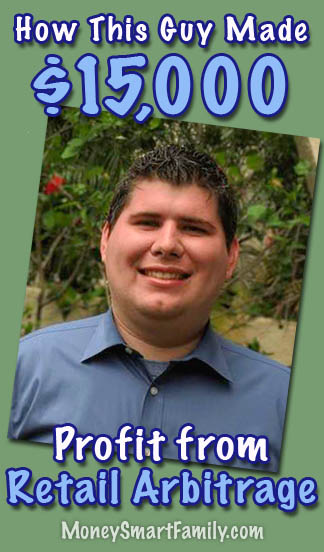
Tyler Philbrook from IamTheFutureMe.com is a relatively new, yet successful retail arbitrageur. This is his full-time job, but he also has other streams of income. He is able to support his family on these earnings. He loves to teach others how to achieve this success.
How did you get started?
I first heard about retail arbitrage by listening to episode 99 of Smart Passive Income with Pat Flynn.
He was interviewing a couple who had started and eventually left their job because of retail arbitrage. One of the stores they mentioned they went to was Walgreens, which is where I worked at that time. So I figured I could not only find the deals easier since I knew how Walgreens worked, but I could also use my discount and get an even better price on things to sell.
When I first started I made so many mistakes, I really thought it wouldn’t be worth it. Eventually, though it all changed. I was able to be more focused and start making money.
Once you got started how long did it become profitable?
It was probably 6 months before I was “profitable.” It took this long for two reasons.
- First, because I was buying things that would never sell in a million years so they just sat there.
- Second: I took time to read and talk to other retail arbitrageurs who were successful.
When did you reach $1,000 in profits?
The first time I hit the “pro seller” status was around my seventh or eighth month. I sold some phones and other electronics and earned well over $1,000.
Are your earnings consistent each month?
I do earn consistently each month. However, there are definitely some months where I earn more than others.
For instance, in December I can very easily earn as much as the first 9 months of the year combined. I know some people that have similar companies and they make ALL their money in quarter 4 (October through December).
Is this your full-time income or a supplemental income?
It can be either, it depends on how much you need and how much you have to invest.
Earnings Depend on How Much You Need
My wife and I keep our expenses pretty low, so honestly, we can live off about $2,000 a month of income. If you need more you can do that too, but you need to spend more to make more.
Earnings Depend on How Much You Have to Invest
This business perfectly demonstrates the motto “you have to spend money to make money”.
I’ve found that the percentage I make doesn’t change. Whether I spend $1,000 on inventory or $10,000. I’m going to make around 30 to 40 percent profit on it. So, do the math on what you need to spend and you’ll figure it out.
How much do you earn in total each year?
Profit was about $15,000 last year. It goes up every year, I’m expecting a lot more this year because I’m no longer pouring all the profits back into the business.
I have a set amount of money to go in each month which is something I’ve never had before.
This year, I expect to make closer to $30,000 from this business alone. And this will be enough for us to live on.
Not only do I earn income from buying and selling things, but I have a Facebook Ad agency. This also brings in income but I don’t need to make as much as I used to.
What is your number one tip for anyone considering retail arbitrage?
Check the best-selling rank of the item on Amazon. If the rank isn’t low enough it will never sell no matter how “good” a buy you think it is.
Advice for Getting Started
The potential profits for retail arbitrage are motivating, use that motivation to get yourself started.
If you are interested in making this your next side hustle, then the best way to start is to get started with some small things.
But also learn from people who have been there and succeeded. Take some of their free course or pay for their coaching courses. If you invest some money in learning, you’ll probably work a little harder at making this a profitable side hustle.
Do not let fear hold you back.
If you are worried about losing money, then just start with a small amount of money and work from there. Start with a small number of items and move up from there.
Make sure to analyze each purchase to ensure that it is a good deal for retail arbitrage before making a purchase.
Is retail arbitrage your next side hustle? Let us know which of these types of retail arbitrage you’re wanting to try.
And let us know if you earn enough money to help you reach your financial goals! We’d love to cheer with you.
Author: Sarah Sharkey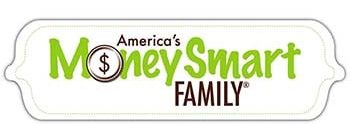

The dark side of this is:
Our local thrift stores have raised their prices considerably specifically to discourage this. What was happening is that a particular person was coming in when they opened and buying the best deals. It got to be “What’s the point?” for everyone else, and the store was left with only the lower-quality goods. So they raised prices for everyone, leaving her to actually leave some bargains for others.
Don’t be a hog or shelf-clearer. Our local Kroger, due to ONE person, will no longer let you prepay for deals that are out of stock or issue rainchecks. When the deals are gone, they’re gone. Why? Because someone greedy was not only clearing shelves, but then either getting a raincheck and then couponing on top of it, or prepaying on loss-leaders for amounts that were obviously for resale. She ruined it for the rest of us.
It’s one thing to be savvy and smart (as in your examples). It’s completely another to be selfishly greedy where it negatively affects everyone else.
Julie – thanks for sharing your experience. That really stinks about the one person cleaning out the thrift store deals.
We love when people find deals, but you’re right, we’ve got to be considerate and not be “piggish!”